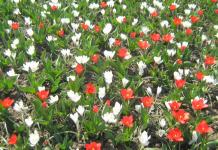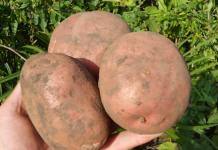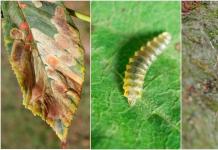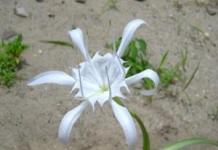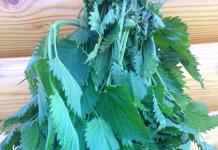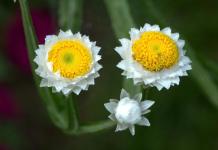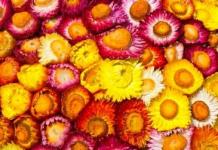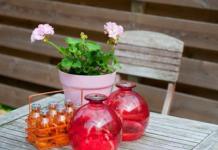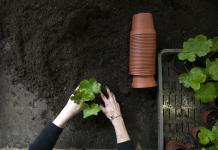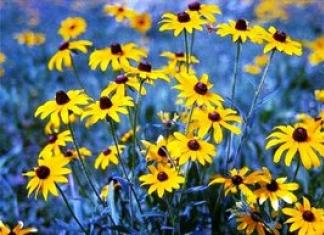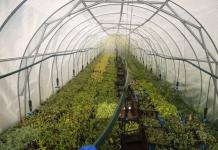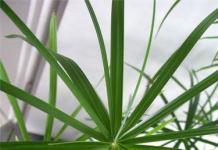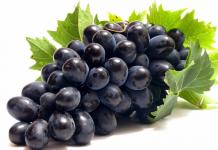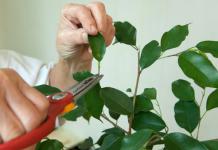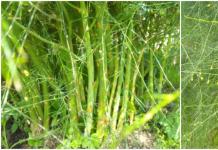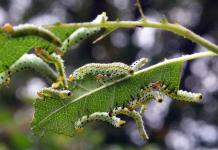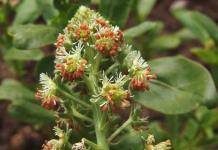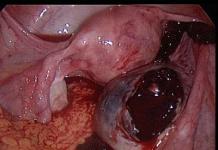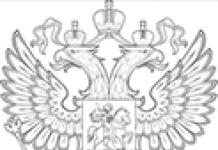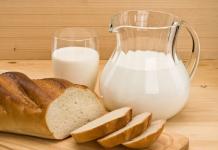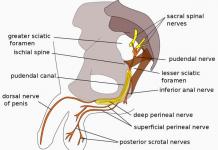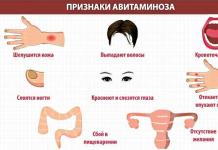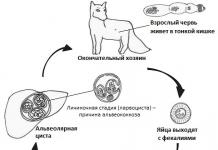In the cultivation of pelargonium, a clear annual cycle, which depends on temperature and illumination. Usually, the flowering time in our climate begins in spring and can last for some varieties until late autumn, as long as there is enough light and warmth.
Lighting
When growing pelargonium, it must be remembered that these are light-loving plants. Planted in the open ground or taken out into the open air for the summer, they perfectly tolerate direct sun. The exception is royal pelargoniums, which are more picky about the effects of wind and rain, so it is preferable to grow them on terraces, balconies and window sills, in sheltered places. If pelargonium is placed indoors (in a greenhouse, on a window), where light enters through glass, the plant may overheat, especially in conditions of poor ventilation. Then you need protection from the scorching summer midday sun. It will take out pelargonium and a little shading, but with a lack of light, the lower leaves will begin to turn yellow and die off, the stem will be bare, the plant will not bloom.
It is important to regularly, once every few days, turn the plant at a small angle relative to the light source, this is necessary for uniform crown growth.
Temperature regime
In summer, pelargonium prefers moderate heat, within + 17 + 23 o C. Landing in open ground should be done only when the danger of return frosts has passed. At a stable temperature of +12 ° C and below, pelargonium ceases to bloom, and too high a temperature, especially in a closed room, also negatively affects flowering. The fact that the plant is cold can be signaled by reddened leaves.
In the fall, the temperature of the content and the abundance of watering are gradually reduced - growth should not be active so that pelargonium does not stretch and deplete under low light conditions.
Winter care
Optimal wintering conditions can be created on a glazed and frost-free, well-lit loggia or in a greenhouse. It is necessary to maintain the minimum temperature at night not lower than +6 о С, in the daytime - about + 12 + 15 о С. In case of overheating on sunny days, open the greenhouse doors for ventilation. Angels, bicolor and tricolor varieties are best kept at higher temperatures, placing them in warmer places in the greenhouse or loggia.
Good air circulation around the plants is essential, they should not be placed too closely, if necessary, thick roots should be thinned out a little. This will help to avoid the occurrence of fungal diseases. Watering this time is rather scarce, experienced growers spend it from pallets, clearly measuring the amount of water and determining the time of the next watering by the weight of the pots, while the top of the soil is always left dry.
There are also other wintering methods... One is to keep the plants as rooted cuttings and discard the mother plant. The method is used in the summer cultivation of pelargonium in the open air.
The second method is also used for outdoor cultivation: on the eve of frost, the plant is dug up, excess soil is shaken off from the roots, the plant is cut tightly and wrapped in paper, then hung in a cool basement. The room should be well ventilated and high humidity so that the plant does not dry out. In the spring it is planted in a pot, with the onset of heat, it is planted in open ground. You can combine the first and second methods: first take the cuttings, and then send the mother plant to the basement for the winter.
Wintering occurs during the darkest time of the year and lasts approximately 2.5-3 months (from November to February). Already in late January - early February, with an increase in daylight hours, pelargoniums gradually begin to wake up.
Watering
When watering pelargonium, it is important to remember that these are rather drought-resistant plants, at the same time they are easily susceptible to fungal diseases. Therefore, it is better to underfill the plant a little than to water it too much. In summer, water as the top layer dries, provided that the plant is in a warm and sunny place. In winter, in cool conditions, watering should be limited, but not brought to complete drying of the soil.
Signs of over-watering will be lethargic drooping leaves, often with signs of gray rot; in a severe case, stem rot will begin, which almost always leads the plant to death. Another symptom of excess moisture is the appearance of "sores" on the underside of the leaves. When the earthen coma dries out, the plant stops blooming, the leaves turn yellow, their edges dry out.
Air humidity for pelargonium is not important, these plants do not require spraying. Excessive dampness and stagnant air can cause fungal diseases.
Top dressing
It is advisable to introduce top dressing with each watering, accordingly reducing the dosage. So, if watering is done every day, then we divide the weekly fertilizer rate by 7-10 and give this dose at each watering. If the lump has time to dry out between waterings, then you must first moisten it with clean water. During the winter rest, feeding is canceled if the temperature is kept low and the plants are completely resting. When there is even a small growth, fertilizers can be added in ¼ dosage. Soon after the cuttings have taken root, a fertilizer with a high nitrogen content is used. For feeding young plants that are not yet allowed to bloom, a complex universal fertilizer is used. Before the onset of the flowering period, approximately 2.5-3 months (in April), they begin to use fertilizer with a higher potassium content. If there are signs of chlorosis, it should be treated with magnesium sulfate and iron chelate (or just a solution of microelements in a chelated form).
Landing
Priming Pelargonium prefers fertile and well-drained. It consists of sod land, humus, peat and sand in approximately equal proportions.
Life span a separate pelargonium bush is usually 2-5 years old, after which the plant loses its decorative effect and it is better to take care of the renewal in time by rooting cuttings. It will take about a year or more to grow an ornamental flowering plant from a cuttings. Cuttings rooted in early spring can bloom this summer, but it is advisable to give preference to the formation of a beautiful bush for abundant flowering next year.
Cuttings can be taken at any time, from early spring to autumn. But here it is necessary to take into account the time of the onset of flowering of the plant, which for different varieties is from 16 to 20 weeks after the last pinching or pruning (flowering occurs on young shoots that have reached this age). If you have a single copy of this variety, then you will have to wait until the end of flowering to cut the cuttings. If there are several copies, then it is better to take cuttings earlier, starting from February-March, then the young plant will have more time to develop for lush flowering next year, until this moment it is necessary to remove all emerging buds. It is not recommended to take cuttings earlier than the end of January, with a short daylight hours. By this time, the plants are just beginning to wake up from the cool wintering. If you take cuttings from dormant plants, then the level of growth hormones in them is low and it will take more time for rooting. For such pelargoniums as angels, royal and fragrant, it is advisable to take cuttings in late winter or early spring (later, with an increase in the level of illumination, the laying of flower buds will already begin closer to the tops of the shoots). For most varieties of zonal pelargoniums, this period is not so important, since their flower buds are laid along the entire length of the shoot and cuttings can be taken at any time of the growing season.
Cuttings must be cut only from healthy and powerful plants - the stronger and chunky the cutting, the better it will develop in the future. For cuttings, take the apical parts of the shoots about 5-7 cm long, from miniature and dwarf varieties - about 2.5-3 cm.The lower leaves and stipules should be carefully removed, under the lower node, make an oblique cut with a slight slope. Dry the lower cut of the cutting in the air; depending on the conditions, this may take from several hours to several minutes. You can use drugs that stimulate root formation, but pelargonium gives roots well without their use.
It takes 2 to 4 weeks to root, depending on conditions and variety. The roots are formed on the lower cut of the cutting. A mixture of sterile peat substrate and perlite in approximately equal proportions is used as a soil for rooting. It is important that water does not stagnate in the ground. Sterilizing the soil prior to use reduces the likelihood of cuttings rotting. Small pots (6 cm in diameter) or transparent cups (100-200 ml) are filled with the soil mixture and kept on a tray with water until the upper part of the substrate is wetted. After that, the soil is allowed to dry for about a day.
Another way of rooting is also popular. They take two pots, insert a second, narrower pot into a wider one, fill the space between them with soil, and plant prepared cuttings here. They are immersed in the ground by about 1-3 cm (depending on the variety) and pressed lightly.
The next watering is carried out sparsely and through the pallet when the soil dries up. It is advisable, after planting the cuttings, to introduce a systemic fungicide into the soil during the second watering. A greenhouse for rooting pelargonium cuttings is not required. For the first 2-3 days, the leaves may wither (do not put the cuttings in sunlight!), Later they restore turgor.
The optimum temperature for rooting pelargonium cuttings is about + 20 + 22 o C.
After rooting, the first pinch the cutting is carried out when it forms 8-10 leaves. The apical growth point is removed with a sharp sterile knife. This stimulates the growth of lateral shoots from the axils of the remaining leaves. If shoots begin to grow only from 1-2 upper buds, then it is advisable to remove them or pinch them as soon as they give 3 leaves. The next pinching is carried out as the lateral shoots grow, when they form 8-10 leaves. This will ensure lush branching, and subsequently abundant flowering. It is optimal to form a crown in the form of 2/3 of a ball. The last pinching of the plant is carried out no later than 16-20 weeks (depending on the variety) before the expected flowering. Since the flowering is also influenced by external factors (illumination), it can be expected to start in May or June, so the last pinching is carried out no later than February. As it grows, diseased or weak shoots are removed, too rapidly growing are shortened, trying to maintain the uniformity of the roots. Also, cut out all leaves that do not match the grade in size or color.
As a young plant grows, it several times per season transplanted(neat transfer) into a slightly larger pot, not trying to give a large volume at once. Transshipment is carried out only when the roots are tightly entwined with a lump. For a one-year-old plant, the maximum pot size should not exceed: for miniature - 9 cm, dwarf varieties and angels - 11 cm, for other varieties - no more than 15 cm in diameter. The last transplantation of cuttings rooted in this season is carried out closer to the winter rest or after its end at the beginning of the next season.
Pruning an old plant after flowering, taking cuttings
After the end of the flowering of the mother plant, the apical cuttings are cut from it for rooting. Pelargoniums are very susceptible to fungal diseases, so it is advisable to make a cut on the mother plant above the node and be sure to treat the cut with a fungicide, sprinkle it with charcoal or sulfur, these measures will reduce the likelihood of stem rot. It is optimal to carry out cuttings in a warm season, this also reduces the risk of disease. It is better not to remove old leaves that remain on the plant at this time, as lateral shoots will soon begin to grow. As young shoots grow, old leaves are removed. As soon as young shoots grow 8-10 leaves, they are pinched.
To give uniformity to the crown and stimulate good flowering, old specimens are carried out immediately after the winter rest. pruning, remove frail and diseased shoots, shorten long ones, leaving 2 to 5 buds on each shoot. It is undesirable to carry out pruning in the fall, since at home, without strict adherence to the cool wintering conditions, weak lateral shoots are formed, which will have to be removed.
Reproduction
Cuttings... Pelargonium reproduces well with the help of cuttings - this is the main method of propagation of varietal plants, only it completely (excluding cases of the appearance of somatic mutations - spots) guarantees the preservation of all varietal traits in the plant. Read about grafting pelargonium above.
Seed reproduction... Many varieties are hybrid in nature, and even if they can set seeds, plants from such seeds may not necessarily retain the varietal qualities of the original plants. Species pelargoniums and a small number of varieties are successfully grown from seeds.
Mainly on sale you can find seeds of F1 hybrids (first generation) and F2 hybrids (second generation), they are produced by large seed companies by crossing two different varieties. Plants grown from such seeds are not very interesting to collectors, but are more suitable for mass gardening - they are not distinguished by a wealth of colors, but they have increased resistance.
The optimal time for sowing seeds is the end of January - February. With an increase in daylight hours, it will be possible to grow strong seedlings, and the seedlings will most likely bloom this summer. You can sow earlier, but in winter you will definitely need additional lighting so that the seedlings do not stretch out.
For seed germination, use poor sterile soil. Seeds are sown on the surface, sprinkled with a thin layer (literally 2-3 mm) of the soil mixture, spilled and covered with nothing. The optimum temperature for germination is + 20 + 24 o C. You can sow the seeds one at a time in individual small cups, then picking is not required. Seedlings appear in 2-3 weeks.
Diseases and pests
- Great damage to Pelargonium deals gray rot... It appears as a gray bloom on the leaves and other parts of the plant. Its occurrence is provoked by coolness, dampness, waterlogging, poor air ventilation. Especially often, the disease occurs during winter rest, which is why it is so important to provide plants with good ventilation, not to put them close to each other, to remove diseased and unnecessary leaves in time.
- Often found on pelargoniums rust... It appears as concentric yellowish above and brown below spots on the leaves.
- Waterlogged soil can be observed stem decay which manifests itself as dark depressed spots at the base of the stem. This is a sure death of the plant, but you can try to take the apical cutting.
- Verticillary wilting caused by a fungus that infects the conducting system of the plant. The disease manifests itself in a gradual yellowing and wilting of the plant and does not respond to treatment.
- Defeats are also possible with other pathogenic fungi, which cause various types of spotting on leaves, petioles and other parts of plants.
It is important to carry out preventive treatment of plants against fungal diseases in a timely manner, especially on the eve of winter holidays. Plants are abundantly sprayed with preparations or immersed with the crown in a container with a fungicide. It is advisable to use systemic fungicides of a wide spectrum of action, such as Skor, Topaz, Profit Gold, Topsin, etc. If a fungal disease is detected, diseased parts of the plant are removed, and the treatment is carried out with the same preparations.
- Pelargonium is often affected whitefly... When purchasing a plant, carefully examine the lower part of the leaf for the presence of small white butterflies or white capsule formations, their larvae. If you find at least a few individuals, you should refuse to purchase.
- Upon detection mealybug it is also better not to buy a plant. In the axils of the leaves, on the stems, you can see clusters, similar to pieces of white cotton wool.
- Also, pelargoniums can be affected thrips, aphids, mites.
Physiological disorders not associated with diseases or pests
- Reddening of the leaves... The reason is too low temperature. The conditions of detention must be changed.
- The plant does not bloom although his general condition is good. The reason may be too high a temperature, lack of light, or excessive watering.
- The leaves turn yellow and fall off, the edges of the leaves dry... The reason may lie in insufficient watering, with a strong exposure of the stem, in a lack of light.
Photo: Nina Starostenko, Rita Brilliantova
Pelargonium is a prominent representative of perennial plants that are popular with gardeners and are used in interesting landscape design solutions around the world. Moreover, this plant comes from South Africa.
Pelargonium is sometimes called geranium due to their similarity.... Also, these two different plants are close relatives, since they are representatives of the Geraniev family.
This confusion about the names of these plants began in the 18th century. Then the Dutch botanist Johannes Burman proposed to separate them into two separate genera, but earlier the scientist Karl Linnaeus mistakenly combined them into a general group. The final decision was made by the Frenchman Charles Louis Laritier, who singled out pelargonium as a separate genus.
Abroad, pelargonium has long been considered a plant that only wealthy aristocrats can afford to grow in their greenhouses. In our country, pelargonium was not very popular for some time..
We suggest watching a video about how pelargonium differs from geranium:
Similarities
Karl Linnaeus, they were united by the similarity of the fruit pod, which after fertilization resembled the beak of a crane due to the stretching pistil. The stems of both plants are erect, and the leaves grow alternately and are covered with small hairs. Plants have a specific aroma, multiply easily and are unpretentious..
Differences
- Genetic difference, therefore, it is impossible to get seeds from crossing them.
- Climatic features. Pelargonium is more thermophilic, and geranium can bloom even at 12 ͦС. This is due to its native habitat: pelargonium - South Africa, geranium - the Northern Hemisphere.
- External differences in flowers and their shades. Pelargonium flowers are combined into large inflorescences, while the corolla is irregular in shape - 2 petals are larger and are located on top. Geranium has single flowers of 5-8 petals. Geranium flowers are never scarlet, and pelargonium flowers are never blue.
What does the plant look like?
Pelargonium is a representative of perennial herbaceous plants, sometimes it is possible to meet shrub species. Pelargonium grows from 30 to 80 cm... Erect stems with alternately growing leaves. In this case, the shape of the leaves will differ for each species - simple, finger-dissected, finger-like.
Umbrella inflorescences. Flowers of cultivated species are larger than wild ones and have 2 upper large petals and 3 lower ones smaller. Pelargonium has a peculiar aroma inherent in each individual species, for example, nutmeg, chocolate, citrus.
With the help of hybridization, you can achieve such aromas as peach, lemon, cinnamon, pine, cedar, lilac flowers, rose, vanilla.
Main types: names, descriptions and photos
Currently there are about 280 pelargoniums... The following types are most popular among gardeners.
Zonal
This species can be either small (about 10 cm) or large (up to 1 m). Flowers can be two or three colors. A feature of this species is that the petals may have a dot pattern or a darker egg-shaped spot.
Shades of inflorescences can be very diverse - all shades of red, as well as pink, white, cream, yellow, and even several colors.
Zonal Pelargonium varieties:
- Alice.
- Bolero.
- Flamenco.
- Connie.
- Fantasy.
Royal

The most whimsical and beautiful view. This species got its name for its large flowers (up to 8 cm in diameter) with a non-uniform color, complemented by dark secretion spots or stripes, as well as with a wavy edge.
Royal Pelargonium Varieties:
- Princess of Wales.
- Turkish.
We offer you to watch a video about Royal Pelargonium:
Angel

Small (up to 30 cm) plants with flowers that look like pansies. Less whimsical and continue to bloom all summer.
Pelargonium varieties Angel:
- Black night.
- Angelys Bicolor.
- Madame Layal.
Ivy

This species has a peculiarity - the leaves are dark green in color, resembling the shape of ivy leaves. Inflorescences are most often terry, while the color palette is presented in shades from milky to purple and red.
Ivy Pelargonium varieties:
- Crock-o-day.
- Ice rose.
Fragrant

The most fragrant appearance, because when you touch double flowers and leaves, a persistent aroma is felt. In some varieties, the leaves can be corrugated. The flowers are often not very attractive - they are small in size and dull in color.
Varieties of Fragrant Pelargonium:
- Diamond (pineapple).
- Chocolate Mint (mint).
- Attar of Roses (rose).
Beneficial features
This plant has many beneficial properties, therefore it is also used in medicine and cooking.
Most often they use fragrant and pink pelargonium.
Cooking
- Since many varieties of pelargonium have a pleasant aroma, their leaves and flowers are used in the preparation of compotes, added to vodka, brandy, frozen in ice, added and decorated with desserts.
- Antiseptic properties are used in jam preparation to prevent mold.
Medicine

Highly use this herb with caution when treating children, preventing ingestion.
Pensioners and people with chronic diseases should, before using drugs that contain pelargonium, check with a doctor for information.
Learn more about the medicinal properties of pelargonium and its use in traditional medicine.
All about reproduction
Seeds
 Seeds are best sown at the end of winter (January-February). When planting earlier, it is necessary to provide additional lighting so that the seedlings do not stretch too much. The seeds are planted in prepared and moistened soil and sprinkled with a thin layer of 2-3 mm soil. It is best to keep the container or individual cup at room temperature in a bright place.
Seeds are best sown at the end of winter (January-February). When planting earlier, it is necessary to provide additional lighting so that the seedlings do not stretch too much. The seeds are planted in prepared and moistened soil and sprinkled with a thin layer of 2-3 mm soil. It is best to keep the container or individual cup at room temperature in a bright place.
The first time, watering is carried out as needed and by spraying... After the shoots have appeared, water as a normal plant, avoiding contact with leaves and stems.
Pelargonium should be dived after the first true leaf appears. A plant grown from seeds will bloom in about six months.
Houseplant care
Pelargonium belongs to unpretentious plants.

Learn more about caring for pelargonium at home in.
Growing at home, on the balcony and flower bed
- Gray mold on the leaves can come from over-watering. It is necessary to remove the infected leaves, dry the plant and treat it with a fungicide.
When the root system or root collar decays, most often the plant dies.
- With such fungal diseases as verticillium wilting and rust, preventive measures are used, carried out before the dormant period with the help of fungicides.
- In the fight against whitefly, mealybug, aphids and thrips, insecticides are used and it is better to treat it indoors.
Pelargonium is a flowering plant that is suitable for both balconies and even outdoors. Beautiful flowers will delight the whole summer period, and a unique aroma will be present all year round.
Pelargonium is a southern plant from the Geranium family, native to India and South Africa. Pelargonium has many similarities with geraniums, which is why they are often confused, but the two plants never interbreed with each other. Pelargonium is a southern and thermophilic plant, it is more fastidious than its northern "sister", does not have blue tints in flowers. Due to its differences from geranium, it also has its own characteristics in home care.
Photo
Check out the photo of pelargonium, which even a novice florist can grow, following our recommendations step by step:



How to properly care for a flower?
Temperature
The optimum temperature for pelargonium during the period of active growth and flowering is kept within + 20-25 degrees. During the dormant period - from October to February - the plant is kept at an average temperature of + 12-15 degrees during the day and not lower than +6 degrees at night. However, there are varieties that are more thermophilic.
Important. A lower temperature in winter is essential for good bud-setting and fuller flowering in the future.
The plant does not like strong drafts and strong temperature changes. Despite this, the air around the pelargonium should not stagnate, as stagnant air increases humidity and increases the risk of developing fungal infections.
Light
Due to its origin, Pelargonium is a very light-loving flower that tolerates direct sunlight well. At the same time, on very hot days, the plant should be shaded to avoid sunburn. The flower will feel good on the southern windows, but on the northern shaded ones it will shed the lower leaves, stretch in length in search of light and bloom less.
If it is not possible to put the flower in a sunny place, you can use fluorescent lamps to lengthen the daylight hours.
Watering
 Pelargonium is a fairly drought-resistant flower, however, this means you can forget about watering. The optimal regimen is every two to three days. On hot and dry days, you can increase the number of waterings to one per day, provided the top layer of the soil dries up. It is better to water with settled water at room temperature. Water is needed until the soil layer is completely moistened, i.e. watering not only the near-stem zone, but also over the entire surface of the substrate.
Pelargonium is a fairly drought-resistant flower, however, this means you can forget about watering. The optimal regimen is every two to three days. On hot and dry days, you can increase the number of waterings to one per day, provided the top layer of the soil dries up. It is better to water with settled water at room temperature. Water is needed until the soil layer is completely moistened, i.e. watering not only the near-stem zone, but also over the entire surface of the substrate.
Important. There is no need to overfill the plant, because with an excess of water, the stem and roots begin to rot, and the plant will die even after transplanting.
The plant does not like humid air and does not need regular spraying. It is also better to keep it away from those plants that require more frequent watering and humidification of the air.
Soil and fertilizer
The plant needs a well-drained, rich in organic compounds. Pelargonium soil can be purchased at the store or you can make the composition yourself. For this, peat, garden soil, medium-grain sand and humus are mixed in equal proportions. It is important that at the bottom of the bowl with a flower there is a good layer of drainage from expanded clay, finely broken bricks, etc.
Pelargonium care includes regular and fairly frequent - once every 10-12 days. In the hot season, when watering becomes more frequent, the weekly dose of top dressing is divided into seven parts and each part is added with the next watering. Any universal formulation for flowering indoor plants is suitable as a fertilizer.
During the dormant period, feeding is not applied.
Popular feeding options are:
- Bona Forte for ornamental flowering plants (Health series).
Contains a high percentage of potassium and a fairly low percentage of nitrogen. Contains calcium, magnesium, trace elements and humic acid.
- Flower Paradise for flowering indoor and garden plants.
The composition contains nitrogen, phosphorus, potassium. Additional substances - magnesium, six trace elements (manganese, zinc, iron, copper, boron, molybdenum).
All dressings are used according to the instructions for use on the package or a special insert. Do not increase the dose in the hope that it will accelerate growth - an overabundance of micro- and macro-elements is no less harmful than their lack.
Pruning
 allows you to form the desired crown, does not allow the plant to grow into greenery, and also allows you to rejuvenate and heal the bush. For different varieties, the formation of the crown is different, but in all cases the rule about the regularity of pruning is followed: do not let the growth of the flower take its course.
allows you to form the desired crown, does not allow the plant to grow into greenery, and also allows you to rejuvenate and heal the bush. For different varieties, the formation of the crown is different, but in all cases the rule about the regularity of pruning is followed: do not let the growth of the flower take its course.
- A cut of young branches is made with a sharp pruner or a clerical knife at an acute angle, above the leaf node.
- The place of the cut is sprinkled with crushed activated or charcoal, fine ash.
- Old branches and leaves are removed in autumn after flowering, elongated or bare stems are removed.
- There is no need to be afraid of strong pruning up to 3-4 eyes - during the winter the plant will accumulate strength and catch up.
Reference. Thorough pruning is not carried out on Royal Pelargonium.
Informative video about trimming pelargonium:
Transfer
The transplant is usually carried out before flowering and active growth, immediately after wintering, and combined with pruning up to 3-5 buds. It is carried out for the purpose of transferring to a more spacious pot or when transferring young plants from a temporary container to a permanent one. After transplanting, the plant is not fertilized for two weeks to acclimatize. Watering is very moderate, no more than once every three days, when the soil dries up - once every two days.
Read more about transplanting and planting pelargonium.
We offer you to watch a video about the transplant of pelargonium:
Requirements for growing Pelargonium grandiflorum
Royal pelargonium is distinguished by larger flowers in inflorescences and a large number of peduncles. For long-term flowering, it requires certain conditions that are different from the conditions for keeping other representatives of the genus Pelargonium.
Watering and feeding
- Irrigation of royal pelargonium is carried out exclusively with settled water at room temperature (about +22 degrees).
- The plant does not like overflows and quickly begins to rot at the slightest stagnation of moisture in the soil.
- It is recommended to water not through the top layer of the earth, but through the pallet in order to avoid compaction of the earthy clod.
- For feeding, liquid organic compounds with a high potassium content, a low percentage of nitrogen and a large amount of trace elements are used.
- Top dressing is carried out only during the flowering period, in winter the plant is not fertilized.
Possible problems
Due to the intricacies of care, which are not followed by all growers, there are problems with flowering, growth, overgrowth of green parts of the plant, etc.
Does not bloom
 There are many reasons.
There are many reasons.
The most basic ones are:
- excess nitrogen in soil and fertilizers;
- excess moisture in the air;
- too dry air;
- excessive watering;
- lack of minerals;
- overgrowth of the flower without long-term rejuvenation;
- improper maintenance in winter.
Most often, the lack of flowering is caused by a complex of reasons. The plant, although unpretentious in care, requires a certain amount of attention. Otherwise, you can get either a green bush or a bare stem.
We suggest watching a video about why pelargonium does not bloom:
Pests and diseases
- Blackleg appears when waterlogged, excessively dense soil, as well as when using contaminated soil. It is impossible to save the plant, the only way out is to cut off the still living shoots, and throw out the stem, root and earth.
- Gray mold appears with excessive humidity. The affected leaves are removed, the plant is treated with antifungal agents and transferred to a drier place.
- Sometimes plants are attacked whiteflies and spider mites. To combat them, chemicals are used, they are treated 2-3 times to completely destroy all eggs and larvae that could survive after the initial treatment.
- To combat blackleg, the soil is treated with Fitosporin before planting, or with a solution of potassium permanganate (3 g per 10 liters of water).
- Treatments with Ronilan, Rovral, Topsin M and other antifungal drugs in the concentration indicated on the package help against gray mold.
- Fitoverm, Actellik, Sunmight and others help against spider mites and other pests.
You can learn more about the diseases and pests of pelargonium.
Pelargoniums are widespread for their unpretentiousness and flowering. The essential oils secreted by them have a bactericidal effect, heal the air in the room, and lead to harmony in the psychological climate. Proper care will ensure an active and powerful flowering every year.
Related Videos
We offer you to watch a video about the proper care of pelargonium:
If you find an error, please select a piece of text and press Ctrl + Enter.
Real geranium is a garden plant. Indoor (it is sometimes called "kalachik", "crane" for its similarity to a crane's beak) is pelargonium. The most popular type of the geranium family, beloved by the people. Therefore, it is called home-grown geranium.
The article will use the words "pelargonium", "geranium", "crane", meaning pelargonium.
Views
 Geranium varieties
Geranium varieties
There are 250 varieties. Distinguish by the shape of the leaves, the color of the inflorescences.
Basic:
- royal
- zonal
- tulip
- unique
- variegated
- dwarf
- rosaceae
- fragrant
Royal
The flowers are large (6 cm). The color is speckled, contrasting. Along the edge of the petal there are corrugations, waves, just a line.
Zonal
Most popular for home use. The most unpretentious of her family.
The leaf plates are round, fragrant, wavy at the edges, with a brown border around. Without pinching, the height is 1 meter.
Flowers are simple, semi-double, double.
Tulip
Lush inflorescences resemble tulips, collected up to 38 pieces. Red, pink, white varieties.
Unique
The leaves are heavily dissected. Spicy aroma exudes. Blooms profusely. The petals are red.
Variegated
Decorative variety. The leaf plates are very beautiful, there are openwork, rounded, tricolor.
Dwarf
Height 13-28 cm. Blossom luxuriantly, abundantly, long. The bush is neat, without formation.
Rosaceae
Inflorescences are small roses, lush, 19 - 20 pieces.
Fragrant
Over 150 fragrant varieties.
PECULIARITY... Each has its own aroma: apple, lemon, cinnamon, rose, strawberry.
The smell kills germs. Used for the production of essential oils.
Care after purchase
 Geranium from the store
Geranium from the store
The purchased plant has undergone several stresses: nursery, transportation, transshipment base, warehouse, shop, apartment. Therefore, until the moment of adaptation to new conditions (3 weeks), it must not be touched. \
You should take good care of: maintain the temperature, soil moisture, air. Treat with the drug Fitosporin.
When the habituation period has passed, you can transplant.
Growing conditions
Temperature
Optimal: +23 degrees in summer, +15 in winter.
Air humidity
It tolerates dry air well. Humidity is the same. It is impossible to spray.
Lighting
Abundant flowering is provided by good lighting. Otherwise, the bush stretches out, there are few flowers, they quickly fall off.
Choosing where to put
Pelargonium is photophilous. It is necessary to choose sunny windowsills.
No drafts and low temperatures.
 Geranium on the windowsill
Geranium on the windowsill
- A white, purple crane is placed anywhere in the room. Red - closer to the window: from the evil eye.
- The positive magical properties are enhanced by the proximity to the azalea or the Decembrist cactus.
- In summer, it can be placed on both sides of the porch, in front of the windows. Will be home decoration. Will bring a good mood to the hosts and guests.
- Astrologers believe that geranium is more energetic for Aries. Soothes Pisces, Scorpions, Aquarius. For the rest of the signs, it is a talisman.
What it looks like in the interior
This flower will decorate any interior, give it more freshness. There is a popular belief that geranium is a talisman at home.
Care at different times of the year
In the spring
From the first days of March, it is necessary to prune: remove old, drying shoots, thin out thickened areas. Remove autumn branches that have grown over the winter with one stem, leaving four points of growth. New ones will soon grow. After 5 weeks, the bush will be covered with many magnificent inflorescences.
Trimmed cuttings will take root perfectly.
IMPORTANT. After cutting, good lighting is needed as much as possible. Put it right by the sunny window. It is good to apply a growth stimulant. Spray the buds 2 times a week.
Having cut off, transplanted.
Summer
Water regularly, feed. Remove wilted inflorescences, pinch, trim. If the rains are lingering, pelargonium, taken out under the open sky, is returned home.
In autumn
At the end of September, flowers are brought home.
The main task is to prepare for the winter. Water a little, regularly. Fertilize once in three weeks.
Pelargonium begins to bloom less: it prepares for pre-winter pruning. The cut stems are used for propagation.
Winter care
 Geranium in winter
Geranium in winter
They stop feeding, water less, provide a temperature of +14 degrees. But the illumination must be sufficient. It is good to use special lamps. Optimally placed near the southern windows.
ATTENTION. You cannot trim.
How to care during flowering
To bloom, you need small containers. When the roots fill the pot, the crane begins to give strength to the blooming of the buds.
The soil mixture should be chosen directly for flowering plants.
Care - regular feeding. Especially potash fertilizers.
Nitrogen is sometimes desirable. An excellent fertilizer is sold special mixtures, where there is an additional content of copper, manganese, iron.
Organic matter cannot be used. You can hurt.
Water abundantly, but rarely.
If you provide sufficient lighting, the crane will delight as long as possible: March - December.
IMPORTANT. When it blooms, it is forbidden to cut, pinch: the formation of buds is disturbed.
How to care after flowering
PECULIARITY. Winter is a dormant period.
You need to prepare for your winter vacation.
Put in a cool, well-lit room, where +11 degrees. Avoid drafts.
After a couple of weeks, bring it into the room.
Prune immediately after the last blooming bud. New shoots will appear. By the spring, a lush bush will form, magnificent inflorescences will appear.
After this procedure, add a complex fertilizer mixture.
CAREFULLY. Pelargonium does not tolerate fresh organic matter.
Can I grow in the garden?
It is a thermophilic plant. Therefore, it is planted under the open sky in the summer.
Determined with the time of planting: the first half of May. The soil temperature should rise to 17 degrees.
 Geranium in the flowerbed
Geranium in the flowerbed
Choose a well-prepared, loose, drained soil. They also use a commercially available universal.
Seedlings are being prepared.
Make holes. Deeper than the length of the roots by 25 cm. The bottom is covered with drainage (gravel, broken brick). Above - a mixture of peat, humus sand.
Then pour over, mulch with dry peat.
REFERENCE. Several bushes should be planted in islands. Between them 25 cm.
Care: watering, feeding, pruning.
Before the onset of frost (better earlier), they dig it up, place it at home by the windows.
With the arrival of a warm time, they are again taken out of the dwelling. Such a transplant is not necessary. Geranium can constantly grow at home
Signs of improper care
Faded foliage signals improper care.
- Insufficient sunlight.
- Improper hydration
- Failure to comply with the temperature regime.
- Uncomfortable humidity.
- Unsuitable container.
- Lack of dressing.
These factors are the causes of the appearance of diseases, pests.
Transfer
The best transplant period is the waxing moon phase. The procedure is carried out in the spring every two years.
An appropriate pot is prepared. The bottom is covered with drainage, you can use small pebbles. Then a bush is placed, the container is filled with moistened soil, watered. Shaded.
 Geranium transplant
Geranium transplant
After a week, it is transferred to a permanent place. Top dressing begins when two months have passed.
Landing
For planting, a container is selected that has drainage holes 24 cm deep from below.
Wash the pot, rinse with a weak solution of potassium permanganate.
The soil should be loose, dry quickly.
For a successful planting, pour a layer of expanded clay, on top - sand, earth. Make a deepening. Place the seedling. Cover with soil mixture, water.
Reproduction
It is easiest to propagate by cuttings. In a strong bush, the top with three leaves is cut off. The cut is sprinkled with activated carbon, planted in the intended place.
Before this, the soil is spilled with boiling water, then with potassium permanganate, with a pink solution.
Another way: the stalk is placed in water. When the roots appear, they are moved into place.
Division method: the bush is divided during transplantation. A separate container is prepared for each part.
Seed propagation is more laborious. Sowing time is January. The place of sowing seeds is small cups. The seeds are laid out, sprinkled with soil, covered with transparent material. Are watered by drip.
 Geranium propagation
Geranium propagation
After the emergence of two leaves on the shoots, they dive. After 7 weeks, they are seated in places.
Pruning
The main task is to thin out the crown. Ventilation will improve, more moisture and sunlight will get in.
All shoots directed inward are removed.
A lush, long flowering is achieved.
The knife for this procedure is disinfected with an antibacterial agent. Hands are also rubbed with alcohol. The stems are cut at the leaf nodule. Sprinkle the cut with cinnamon powder or activated carbon. Then they are fed with a nitrogen-containing fertilizer.
Rejuvenation
Produced in two ways:
- Radical - cut, root cuttings.
- Gentle - spring pruning.
The tops are used for grafting. Cut off 6 cm, sprinkle with activated charcoal. Dried for 3 hours, planted.
Pruning is carried out immediately after the winter rest. The order was discussed earlier.
Does the plant have a dormant period?
Winter is a dormant period. From October to March, abundant moisture stops, most of the greenery is cut off, and the temperature remains cool.
Watering and other water procedures
It is watered all year round with clean water. Better melt or rainwater. The tap water is cleaned of various impurities, filtered.
Water hardness can be softened:
- Wood ash: liter of water - 10 grams
- Fresh peat: a liter of water - 15 grams
- Oxalic acid: bucket - 0.3 grams
Temperatures in spring and summer should be slightly warmer than room temperature. It is slightly cooler in autumn and winter. In this case, the crown should be protected from moisture.
 Watering geranium
Watering geranium
Moderate, regular hydration should be maintained. Sharp fluctuations in abundant watering and drought negatively affect the condition of the crane.
In the summer, watered daily. In the fall, the frequency of watering decreases. Until spring - the beginning of a new flowering season.
It is impossible to spray.
For watering to be effective, you should choose a pot that matches the volume of the root system. Optimal: height - 15 cm, diameter - 25 cm.
It is better to buy clay: plastic ones retain moisture, the roots rot.
Once a week, it is necessary to stimulate growth, strengthen the roots: water with a solution of iodine (liter of water - 1 drop).
With prolonged bad weather, watering is reduced. In drought, increase.
Errors:
- There are no holes in the planting pots to remove excess moisture.
- From autumn to spring, frequent, abundant watering continues.
- A sharp fluctuation in watering from abundant, frequent to scarce, rare.
Top dressing
Produced in spring - summer. Twice every month. First shade (if it is under the sun for a long time), then water, fertilize.
One-component dressings are used: phosphorus, nitrogen, iodine, potassium.
You can use complex, where various minerals are present.
Fertilizer mixtures are introduced according to the attached instructions.
REFERENCE. Organic matter is applied once every three years, being careful. Otherwise, the plant may die.
Diseases and pests.
 Geranium diseases
Geranium diseases
Diseases
Fungus
Covered with down, gray spots. The reason is excess moisture.
It should be cleaned of dead areas, treated with fungicides.
Roots rot
From infection by a fungus. The leaf plates turn yellow, then turn black, the flowers are covered with a cobweb.
It is necessary to loosen the soil, exclude nitrogen fertilizers, remove diseased parts, apply fungicides.
Rust
The leaf plates are covered with rusty yellow spots. Rot, blackness appears.
ATTENTION. It is treated effectively until blackening appears.
Dead fragments are removed, treated with fungicides.
Chlorosis
There is a lack of mineral fertilizers.
The border of the leaf plates has brightened - there is not enough nitrogen.
The whole plant turns yellow - sulfur deficiency. Old leaves are covered with spots - there is not enough magnesium. If new - lack of iron. The absence of phosphorus is indicated by a yellow spot
Treatment is a balanced compound fertilizer.
Blackleg
The disease is fungal. The stem is affected. The reason is heavy soil.
It is useless to treat.
Late blight
The leaf plates curl up, wither. When a disease is detected, it is already useless to treat.
Prevention is done with drugs "Ridomil", "Previkur".
The buds wither
Not enough phosphorus, boron. The reason may be dry air, heat.
It is necessary to make foliar feeding, create an optimal temperature - 18 degrees, moderate moisture.
CAREFULLY. Do not abuse nitrogen. Otherwise, there will be no inflorescences.
Pests
Aphid
It multiplies quickly. Drinks juice: the leaves curl, dry up.
Affected fragments must be removed, processed Fitoverm.
Spider mite
Signs: cobweb, white dots on the leaf plates.
Apply drugs Fitoverm, Akarin.
Nematode
Small worms eat the roots. Processing something is useless. Destroy the soil, the plant.
How to reanimate?
When it dries up completely, you must:
- Examine the bush. If saving a live trunk, remove for the winter: find a cool place. New stems may appear in the spring.
- If the trunk is also dry, dig out the root, soak it. He can give roots.
- Plant.
Prophylaxis
- Timely transplant
- Suitable pots
- Moderate hydration
- Draft protection
- Correct feeding
- Destruction of pests
- Timely removal of yellow leaves.
By carrying out competent prevention, any disease can be cured.
Useful and harmful properties
 Geranium oil
Geranium oil
Benefit
The scent of the leaves disinfects the air. Disease-causing bacteria are destroyed.
Home energy improves. Serves as a talisman against negative emotions.
Leaves, juice, stems are used to treat: colds, calming the nervous system. Treat headache, blood pressure, gastrointestinal tract, throat ailments, runny nose, toothache, ear pain. Promotes the removal of kidney stones, elimination of pain in the spine, joints. They help to quickly fall asleep, heal burns.
Juice, oil, broth are widely used in cosmetology.
Essential oil improves health, normalizes acidity, and improves digestion. Eases neurological pain. Used in the treatment of lupus, sclerosis.
When applying, it is imperative to dilute with olive oil, sesame oil.
Harm, contraindications
The most common problem is allergies. Manifested by headache, cough, swelling, nasal congestion. If this happens, you need to get rid of the geranium.
Medicines prepared on its basis are contraindicated for: increased blood viscosity, low blood pressure, stomach ulcer, individual intolerance. Cannot be used by children under 3 years old, pregnant women, elderly people.
Frequent mistakes
 Geranium inflorescences
Geranium inflorescences
- The main mistake is the lack of lighting. It should be kept by the window, where there is a lot of sun. In summer, you can sit on the balcony. Otherwise, the beauty of the pet becomes extinct, loses its splendor, brightness.
- Incorrect pot size.
- Overfed with nitrogen. Only one green mass grows. It is better to fertilize with a universal mixture.
- Lack of rest period from December to February. Winter care needed. You cannot trim.
- Lack of formation. It is imperative to do pruning, pinching in the spring. Otherwise, a huge bush with crooked half-naked stems will grow.
- Low (less than 10 degrees) temperature. Optimal - 18 degrees
- Excessive moisture. There is no drainage. Roots rot
- Insufficient moisture. Leaves dry around the edges
- Depleted soil. It is necessary to replant every 3 years
Question answer
Question. If hot tap water is diluted with cold water, will it be irrigated?
Answer. Their chemical composition is identical. If it is soft, then you can use it.
Question. The geranium is dry. How to recover?
Answer. It is necessary to fill the container with warm water for 10 minutes until air bubbles are released.
Question. How is air humidity maintained?
Answer. Put the container and water. Or use a special humidifier.
Question. What is the best material for planting drainage?
Answer. Broken brick, small stones, expanded clay.
Useful video
Find out more about caring for geraniums in the video below:
Output
The beauty of pelargonium does not bring much trouble. But the house fills with positive energy, tranquility and strength. Every dwelling should have such a modest, but reliable and strong crane.

Pelargonium treats well, so it should be watered sparingly and the soil should not dry out. Although drought can tolerate normally.
But it is better not to plant it in the open sun either: the optimal temperature for growth and development in pelargonium is + 15 ° C, therefore the semi-sunny side is considered the best, or it will still have to be shaded.
Depending on the species, pelargonium has a number of individual characteristics, but the principle of planting and care is by and large the same. To root green cuttings in the garden, you need to plant them in a mixture of peat and river sand. But it can also be rooted at home using.
Pelargonium care
Dormant period
Once in the garden, pelargonium blooms all summer. But like any living organism, it gets tired, so let the plant rest for about 1.5-2 months until spring, put it at rest. To do this, do not water pelargonium and do not feed with mineral fertilizers. By spring, she will wake up and give flowering again. There are many opinions about the wintering of pelargonium. But I would not dare to leave it in the garden: for the winter, the bush must be transplanted into a pot and taken home.
Pelargonium should not be left in the garden for the winter. Potty her and take her home
Fertilizers
During the period of active pelargonium, use complex fertilizers for flowering plants.Pruning
In the spring, so that pelargonium actively starts to grow and pleases with abundant lush flowering, the tops of the shoots can be pinched. But the tops do not have to be thrown away, they can be rooted and new plants can be obtained.
The tops of the shoots need to be pinched so that next year the bush is lush
Reproduction of pelargonium
Pelargonium propagates by seeds and vegetatively (green cuttings).- Many hobbyists root the cuttings right in the winter, for this they plant the cuttings in sand or perlite and moisten them. Cuttings are cut from mother plants, wintering at home at a temperature not higher than + 12 ° C. The cuttings are rooted from January at + 16 ° C, already at this temperature the plant begins to give roots. Then the temperature is increased to + 20 ° C, the formation of a full-fledged root system of the cuttings takes about 3 weeks. When the root system is formed, transplant the young plants into small pots, take them to the greenhouse for hardening and growing. You can also grow on the window.

Pelargonium cuttings are usually rooted in perlite, but they root well even in water
- Seeds must be sown in containers also in winter, from December to February, the soil mixture should consist of river sand and peat or peat alone. It will take about 3 weeks to wait for seedlings, all this time the soil must be regularly moistened. It is advisable to cover the top of the container with a film. When the seedlings reach the phase of three true leaves, they are dived into separate containers. To make the plant more bushy, pinch it over the 6th leaf.
Types of pelargonium
The genus Pelargonium has about 250 species that grow in South Africa. In our country, the most widespread, which gave rise to many varieties and hybrids, are the item zonal and the item ivy-leaved.Our market will help you - an illustrated catalog of goods from different online stores.
Pelargonium Bulls Eye Cherry F1, 5 pcs.
165 rbl
seedspost.ru
Pelargonium Multibloom Pink F1, 5 pcs.
165 rbl
seedspost.ru
Pelargonium (geranium) Colors palette, Mix, 10 pcs. Farao
75 rbl
seedspost.ru
Pelargonium Knight Appleblossom F1, 4 pcs.
98 rbl
seedspost.ru
Pelargonium zonale
The contoured, patterned leaves of this perennial pelargonium can be light or dark green in color. In a number of well-known sources it is written that this species is annual, but I would say that it simply does not hibernate in the open field. I dig up and transplant it into a pot, so even in winter my pelargonium blooms.
In winter, mother liquors are stored at temperatures up to + 23 ° C. When the plant has faded, the shoots are cut to 10 cm and the container is transferred to a bright, cool room with a temperature not exceeding + 15 ° C. By the way, this species tolerates drought well, has many new interesting varieties and hybrids. Bright color (white, red, dark red, crimson, pink) and spherical umbellate inflorescences with simple or double flowers - that is why flower growers love this pelargonium so much. is able to decorate not only a window sill, but also hanging baskets, tubs and containers, flower beds, ridges or borders.
Pelargonium of this species does not tolerate excess moisture, can withstand temperatures down to -6 ° C, and at temperatures below + 9 ° C, the leaves turn yellow. Varieties and hybrids affect the height of the plant: for example, the variety "Meteor" it is distinguished by its short stature, therefore it is used for borders. And the series "Rocky Mountain" you can find vigorous varieties, and besides, unusual shades.
Medium-sized unusual varieties
- "Rumba Fire"- fiery, I would say, bordering on the "poisonous" saturation of red, attracts attention from any point of view.

- "Bravo Pastel"- petals of white color, smoothly turning into pink, with a delicate crimson eye

Pelargonium zone "Bravo Pastel"
Pelargonium ivy (Pelargonium peltatum)
A favorite of landscape designers for horizontal gardening. Juicy, fleshy leaves, sometimes framed with a red border, attract attention. They do not smell and do not have pubescence, but outwardly they are somewhat reminiscent of leaves in shape. Shoots of this species are falling, up to 90 cm long. Although they can be 30 cm, depending on the variety.
Pelargonium ivy "Apple Blossom Rosebud"
Again, many sources write about the one-year development cycle of this species, but transplant it into a pot in the fall, and it will live on the window until the spring planting back into the garden. It has a semi-shrub appearance. Flowers on long peduncles, gather in few-flowered thyroid inflorescences. They can be terry or semi-double. The color is white, pink, lilac and red.
Most popular varieties
- "Mustang"- deep dark red color.
- "Pygmy"- a relatively new series with salmon pink, cherry, pink flowers.

- "Red Pandora"- a variety of incomparable tulip pelargonium. Its cherry-red flowers will impress even an experienced gardener.

Pelargonium ivy "Red Pandora"
Meanwhile, many breeders subdivide ivy-leaved according to the strength of growth and ampelous colors. In the group of medium-sized varieties, there are many new lilac and lilac shades.

Pelargonium "Lady Ilchester"
Most varieties have fluffy double flowers and variegated colors.

Pelargonium "Richard Hogson"
Low-growing varieties and hybrids also have a lot of new and interesting things. Juicy bright colors and greens, coupled with a low height, are increasingly becoming a welcome guest in the garden. I love simple bright colors.
Variety "Belladonna" as if he had descended from retro pictures of the last century, their exquisite doubleness and tenderness of color scheme becomes a tidbit for a gourmet.

Pelargonium "Belladonna"
There are varieties whose flowers are distinguished by simplicity, but they contain the secret of color change from temperature. For example, flowers of the variety "Cascade White", bronze in heat and cold, under normal conditions become familiar orange colors.
Pelargonium ivy is more sensitive to frost than zonal. It starts to freeze out already at -4 ° C. When planting in the ground, the distance between the plants is taken to be about 25 cm, and if containers or boxes are used, then about 15 cm.

Pelargonium ivy
Finally, I want to say that in the West, gardeners have long been using ivy pelargonium for arched structures. A favorite technique is also a pyramidal structure: to create such an object, boxes are used, which, like steps, are placed on top of each other.

Do you have pelargonium growing?



